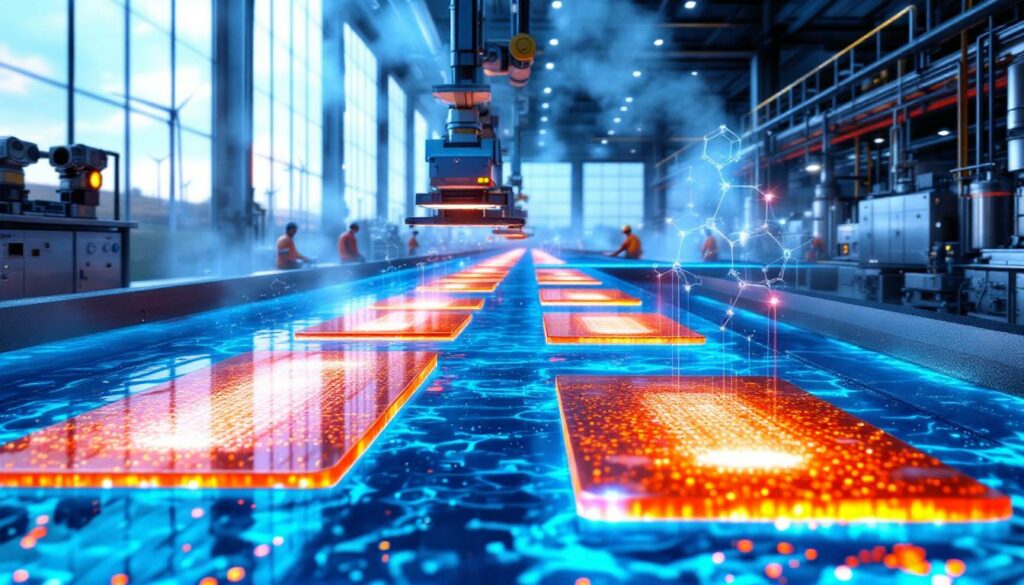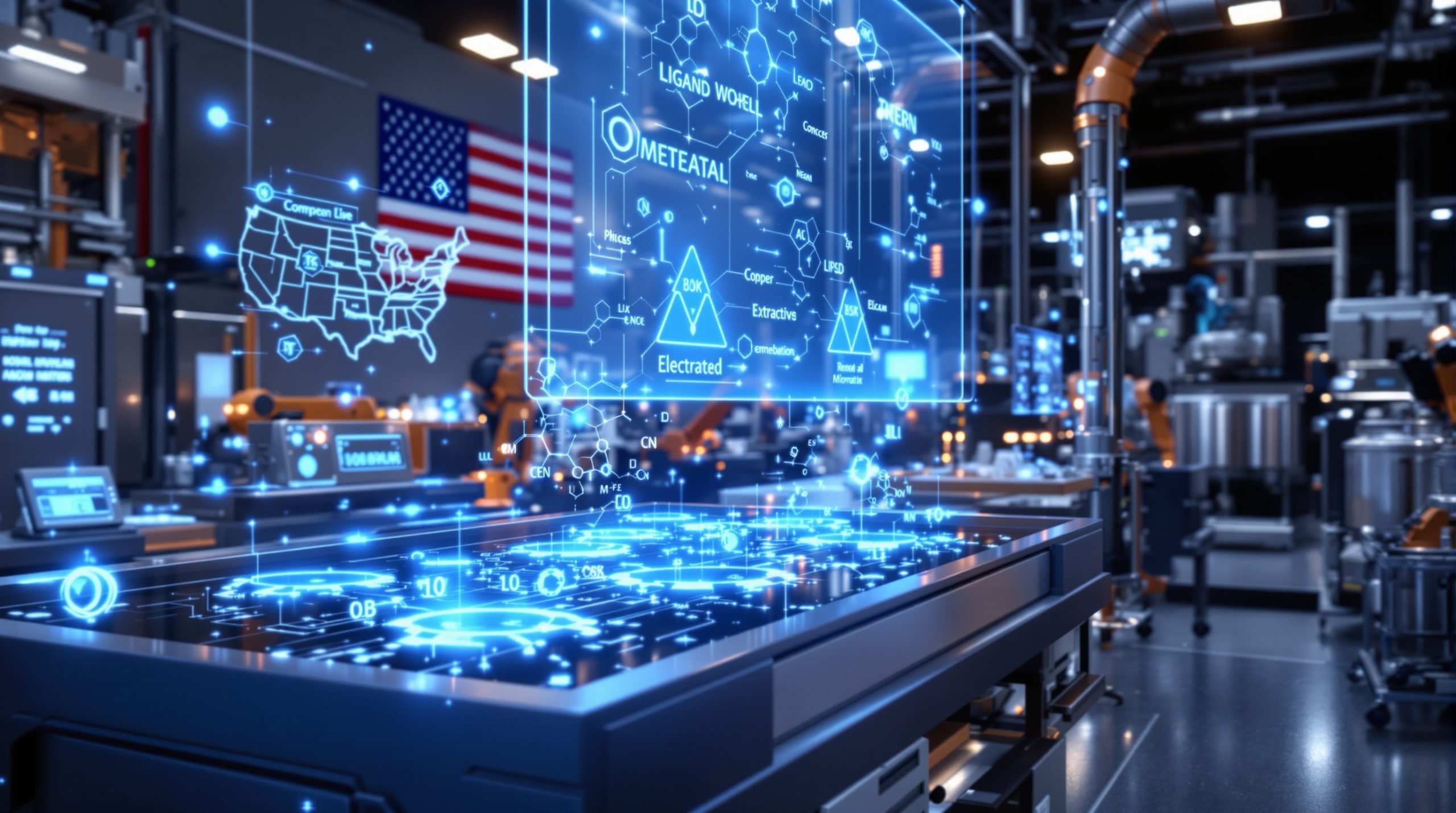What is Electrorefining and Why is it Important for Copper Production?
Electrorefining represents the backbone of modern copper purification, processing over 80% of the world's copper through this sophisticated technology. This electrochemical process transforms impure copper anodes into high-purity copper cathodes through controlled dissolution and deposition in an electrolytic cell. The process effectively separates copper from impurities, allowing for the production of metal that meets the most stringent quality requirements.
The importance of electrorefining in copper production cannot be overstated. As the International Copper Study Group (ICSG) reports show, with global refined copper production exceeding 25 million tonnes annually, the majority passes through electrorefining facilities to achieve commercial-grade purity levels. This purification step is critical because even trace impurities can dramatically reduce copper's electrical conductivity and mechanical properties.
"High-purity copper is the lifeblood of modern infrastructure and technology. Without electrorefining, we simply couldn't meet the quality demands of today's applications," notes industry experts in metallurgical engineering.
The applications requiring this refined copper span several critical sectors:
- Renewable energy infrastructure – Solar panels, wind turbines, and power transmission systems
- Electronics manufacturing – Circuit boards, semiconductors, and microprocessors
- Telecommunications equipment – Data centers, fiber optic networks, and cellular systems
- Clean water systems – Plumbing, filtration, and treatment facilities
With the global shift toward electrification and renewable energy, the demand for high-purity copper continues to accelerate. The World Bank's "Minerals for Climate Action" report highlights that copper consumption could increase by more than 200% by 2050 to support clean energy technologies alone, making efficient electrorefining processes more crucial than ever.
How Does Metso's Enhanced Electrorefining Technology Work?
The Integrated System Approach
Metso boosts copper purity with new tech through its holistic, integrated system approach. Rather than offering disconnected components, Metso has developed a comprehensive solution that manages every stage of the refining process from anode preparation to final cathode production.
The system orchestrates a complex series of metallurgical processes into a harmonious operation. This integration allows for precise control over the entire electrochemical environment, optimizing current distribution, electrolyte chemistry, and physical parameters simultaneously. The result is a remarkably efficient transfer of copper ions from impure anodes to pure cathodes while leaving contaminants behind.
Key Technological Components
Metso's system incorporates several proprietary technologies that work in concert:
- Outotec tankhouse material handling machinery – Automated systems for anode/cathode movement that minimize handling damage while maximizing throughput
- OKTOP process units – Specialized circulation systems that maintain optimal electrolyte distribution and chemistry throughout the tankhouse
- Advanced monitoring systems – Sensor networks that provide real-time data on current efficiency, temperature profiles, and solution chemistry
- Integrated digital solutions – AI-powered analytics that identify optimization opportunities and predict maintenance needs
These components function as a unified system rather than isolated equipment pieces. Each element communicates with others through Metso's digital ecosystem, enabling adjustments based on real-time performance data rather than periodic manual checks.
Modular Design Benefits
The modular architecture of Metso's electrorefining technology offers remarkable flexibility and adaptability:
- Scalability – Operations can start with a base configuration and expand capacity incrementally without complete redesigns
- Implementation flexibility – The modular approach works for both greenfield projects and retrofits of existing facilities
- Maintenance efficiency – Standardized components mean simpler spare parts inventory and easier technician training
- Space optimization – Compact designs maximize copper production per square meter of plant footprint
This modular approach has proven particularly valuable for operations in challenging locations where construction complexity and schedule certainty are critical factors. The pre-engineered modules reduce on-site construction time by up to 30% compared to traditional builds, according to implementation case studies.
What Makes Metso's Copper Electrorefining Technology Innovative?
Seamless Material Flow Engineering
According to Noora Aro-Koivisto, Metso's copper electrorefinery technology manager, the enhanced system enables "seamless material flow" throughout the refining process. This integration represents a fundamental shift from traditional tankhouse designs that often treated material handling as separate from the electrochemical process.
"The integrated copper electrorefining process ensures high-purity cathodes and safe, reliable operation," explains Aro-Koivisto. This seamless approach eliminates the bottlenecks that typically occur at transfer points between process stages.
The innovation lies in recognizing that material movement isn't just logistical – it directly impacts metallurgical performance. For example, smoother anode transfers reduce slime disturbance in the cells, which prevents recontamination of the electrolyte and maintains consistently high purity levels.
Customer-Specific Optimization
Unlike one-size-fits-all solutions, Metso's technology adapts to the unique challenges of each operation:
- Feedstock-specific purification – Process parameters automatically adjust to handle varying impurity profiles from different ore bodies or recycled materials
- Site-adapted layouts – Physical configurations designed around existing infrastructure constraints and expansion plans
- Impurity management solutions – Targeted systems for problematic elements like arsenic, antimony, and bismuth that vary by deposit
- Regional optimization – Adjustments for local climate conditions, energy availability, and labor models
This customization capability has proven particularly valuable for operations processing complex concentrate blends or recycled materials, where impurity profiles can change significantly between batches.
Lifecycle Performance Focus
Metso's approach emphasizes sustainable operational excellence through several key factors:
- Total cost of ownership reduction – Design choices that minimize energy consumption, reagent use, and maintenance requirements
- Cathode lifecycle extension – Advanced surface treatments and material selection that reduce replacement frequency
- Reliability engineering – Redundant systems and predictive maintenance that maximize uptime
- Production consistency – Process controls that deliver uniform cathode quality despite fluctuating input conditions
This lifecycle focus delivers measurable advantages in operational metrics. Case studies from implementations show reductions in energy consumption of up to 15% per tonne of copper produced, while maintenance costs have decreased by similar percentages through predictive approaches.
What Quality Standards Does the Technology Achieve?
London Metal Exchange Grade A Specifications
Metso boosts copper purity with new tech that consistently produces copper cathodes meeting London Metal Exchange (LME) Grade A specifications, the gold standard for commercially traded copper. These exacting requirements include:
| Parameter | LME Grade A Requirement | Metso Technology Achievement |
|---|---|---|
| Copper content | Minimum 99.99% | Consistently achieves 99.995-99.999% |
| Lead impurity | Maximum 5 ppm | Typically below 3 ppm |
| Bismuth impurity | Maximum 2 ppm | Typically below 1 ppm |
| Sulfur impurity | Maximum 15 ppm | Typically below 8 ppm |
| Silver, oxygen, other elements | Strict limits | Well below maximum thresholds |
This exceptional purity is particularly important for high-tech applications where even trace contaminants can compromise performance. For example, in semiconductor manufacturing, where copper interconnects have dimensions measured in nanometers, impurities can cause defects that render entire chips useless.
Quality Control Mechanisms
The technology maintains this high quality through multiple integrated control systems:
- Real-time electrolyte analysis – Continuous monitoring of solution chemistry with automatic adjustment of additives and purification cycles
- Current distribution optimization – Advanced electrode designs and power control systems that prevent edge effects and nodulation
- Automated sampling protocols – Systematic testing regimes that ensure early detection of any quality deviations
- Process correction algorithms – AI-powered systems that identify quality trends and implement preventive adjustments
These mechanisms work together to create a self-correcting system that maintains quality even when input materials vary. The real-time monitoring is particularly valuable in detecting trace contaminants that might otherwise accumulate over production cycles.
"The difference between 99.99% and 99.999% purity might seem small, but for critical applications like medical devices or advanced electronics, that final decimal place represents the line between success and failure," explains metallurgical quality experts.
How Does This Technology Support Sustainable Copper Production?
Energy Efficiency Improvements
Metso's integrated system significantly reduces energy consumption through several technological innovations:
- Enhanced current efficiency – Optimized electrode spacing and electrolyte circulation that minimize energy losses
- Thermal management systems – Heat recovery and insulation technologies that maintain optimal temperatures with less external energy
- Power distribution optimization – Microprocessor-controlled rectifiers that deliver precisely the energy needed at each stage
- Process integration efficiencies – Reduced energy waste during transfers between process stages
Independent energy audits of facilities using this technology have documented electricity savings of 10-15% compared to conventional tankhouse designs. For a typical refinery producing 300,000 tonnes of copper annually, this represents millions of kilowatt-hours saved and thousands of tonnes of CO₂ emissions avoided.
Resource Conservation
The system supports broader sustainability goals through careful resource management:
- Improved copper recovery rates – Extracting up to 99.5% of available copper from anodes, reducing metal losses
- Chemical consumption reduction – Precise dosing and regeneration systems that minimize reagent use
- Water conservation – Closed-loop designs that reduce freshwater requirements by up to 40%
- Equipment longevity – Materials and designs that extend operational life, reducing manufacturing and replacement impacts
These improvements align with the mining industry's increasing focus on resource efficiency and circular economy principles. By maximizing recovery and minimizing inputs, the technology helps reduce the overall environmental footprint of copper production.
Reduced Environmental Impact
Metso's approach contributes to cleaner production through several pathways:
- Enhanced containment systems – Advanced seals and enclosures that prevent solution leaks and emissions
- Integrated waste management – Systems that capture and treat process residues for safe disposal or valorization
- Emission control technologies – Scrubbers and filters that minimize airborne contaminants
- Optimized land use – Compact designs that reduce the physical footprint of refining operations
The environmental benefits extend beyond the refinery itself. By enabling higher recovery rates from existing material flows, the technology helps reduce pressure for expanded mining activities, preserving natural habitats and reducing overall industry impacts.
How Does Metso Support Implementation and Ongoing Operations?
Global Service Network
Metso backs its technology with comprehensive support infrastructure spanning major mining regions worldwide:
- Installation and commissioning expertise – Specialized teams with experience implementing similar systems across diverse environments
- Operator training programs – Comprehensive education covering both theoretical principles and hands-on operation
- Preventive maintenance services – Scheduled inspections and service programs that prevent costly failures
- Technical troubleshooting resources – Rapid-response specialists available for complex operational challenges
This support network encompasses more than 50 countries, ensuring that expertise is available where and when needed. The global coverage is particularly valuable for multinational mining companies seeking consistent technology implementation across diverse operations.
Digital Support Infrastructure
The technology is reinforced by advanced digital tools that extend beyond basic monitoring:
- Remote monitoring capabilities – Secure connections that allow specialists to analyze performance data without site visits
- Predictive maintenance systems – AI algorithms that identify developing issues before they cause failures
- Performance analytics platforms – Benchmarking tools that compare operations against global copper supply forecast best practices
- Process optimization recommendations – Data-driven suggestions for improving quality, throughput, and efficiency
These digital tools create a continuous improvement ecosystem where operational data feeds back into optimization efforts. The result is refineries that actually improve performance over time rather than experiencing the gradual degradation typical of industrial facilities.
"The combination of physical technology and digital intelligence creates systems that evolve with operational experience. Each day of production makes the system smarter and more efficient," notes digital transformation experts in the mining sector.
What Applications Benefit Most from High-Purity Copper?
Renewable Energy Infrastructure
High-purity copper serves as the foundation for the global energy transition:
- Solar power systems – Copper wiring and busbars carry current from photovoltaic cells with minimal resistance losses
- Wind turbine generators – Copper windings in generators convert mechanical energy to electricity with optimal efficiency
- Energy storage technologies – Battery systems rely on copper current collectors and connection systems
- Power distribution networks – Transmission and distribution systems require high-conductivity copper to minimize losses
According to International Energy Agency (IEA) forecasts, copper demand for clean energy technologies could increase by 300% by 2040. This growth is driven by both the expansion of renewable capacity and the higher copper intensity of these technologies compared to conventional power systems.
Electronics and Telecommunications
The electronics industry demands the highest purity copper for several critical applications:
- Semiconductor manufacturing – Copper interconnects in advanced chips require 99.999% purity to maintain reliability
- Circuit board production – High-frequency applications need copper with minimal impurities to prevent signal degradation
- Data transmission systems – Fiber optic network components use copper in connector and amplification stages
- Computing infrastructure – Data centers require massive amounts of high-purity copper for power distribution and cooling
As electronic devices continue to shrink while becoming more powerful, the quality demands on copper increase proportionally. Impurities that were tolerable in earlier generations of technology can cause catastrophic failures in today's miniaturized systems.
Critical Infrastructure Applications
Beyond energy and electronics, high-purity copper plays essential roles in infrastructure systems:
- Water purification – Copper components in treatment systems provide natural antimicrobial properties
- Healthcare equipment – Medical devices rely on copper's conductivity, ductility, and biocompatibility
- Transportation electrification – Electric vehicles contain 3-4 times more copper than conventional vehicles
- Industrial automation – Robotics and control systems require copper for reliable power and signal transmission
The combination of mechanical properties, electrical conductivity, and corrosion resistance makes high-purity copper irreplaceable in these applications. While alternatives exist for some uses, they typically involve significant compromises in performance, cost, or environmental impact.
How Does This Technology Compare to Previous Generations?
Technological Advancements
Metso boosts copper purity with new tech that represents substantial evolution from earlier systems:
| Feature | Previous Generation | Metso's Enhanced Technology |
|---|---|---|
| Automation level | Primarily manual oversight with basic controls | Full digital integration with predictive capabilities |
| Process control | Periodic sampling and manual adjustments | Continuous monitoring with automated correction |
| System integration | Separate systems with manual handoffs | Fully integrated process with digital coordination |
| Monitoring depth | Basic parameters (current, temperature) | Comprehensive chemical and physical parameter tracking |
These advancements reflect the broader digital transformation occurring across the mining industry. By incorporating Industry 4.0 principles, the technology creates refineries that operate more like precision manufacturing facilities than traditional metallurgical plants.
Performance Improvements
The technological evolution delivers measurable operational improvements:
- Higher current densities – Advanced systems operate at 350-400 A/m² versus 280-320 A/m² in previous generations
- Quality consistency – Reduced variation in cathode purity and physical characteristics
- Energy efficiency – Typical reduction of 1.8-2.2 kWh per tonne of copper produced
- Maintenance requirements – Extended intervals between major maintenance events, with up to 25% reduction in downtime
These performance gains translate directly to economic benefits. A modern copper refinery implementing this technology can process more material through the same physical footprint while consuming less energy and requiring fewer interventions – a powerful combination for improving returns on invested capital, making it a key consideration in copper investment strategies.
FAQ: Copper Electrorefining Technology
What is the typical purity level achieved through electrorefining?
Modern copper electrorefining consistently achieves purity levels of 99.99% (four nines) as a minimum standard, with many operations reaching 99.995-99.999% (five nines) purity. This exceptional quality is achieved through precise control of electrolyte chemistry, current distribution, and contamination prevention throughout the process.
The few remaining impurities typically consist of trace amounts of precious metals like silver and gold, which are later recovered in separate processes, plus minimal amounts of elements like lead, bismuth, arsenic, and oxygen. The concentration of these impurities is measured in parts per million (ppm) or even parts per billion (ppb).
How does electrorefining differ from electrowinning?
While both processes use electrolysis to produce high-purity copper, they differ fundamentally in their starting materials and operation:
-
Electrorefining starts with solid copper anodes (typically 98-99% pure) produced from smelting operations. During the process, copper dissolves from these anodes into an electrolyte solution and then deposits onto cathodes, leaving impurities behind either in the solution or as "anode slime."
-
Electrowinning extracts copper directly from a pregnant leach solution (PLS) containing dissolved copper ions, usually obtained through leaching processes. The copper ions in solution deposit onto cathodes when current is applied, without using copper anodes as a source material.
Electrorefining typically produces higher purity copper and is the dominant process for primary copper production, while electrowinning is often used in hydrometallurgical operations, particularly for oxide ores and some secondary recovery operations, including those in [US
Ready to Capitalise on the Next Copper Boom?
Take advantage of advanced insights with Discovery Alert's proprietary Discovery IQ model, which provides instant notifications on significant copper discoveries on the ASX before the broader market responds. Visit the Discovery Alert discoveries page to understand how major mineral discoveries can lead to exceptional returns and begin your 30-day free trial today.




